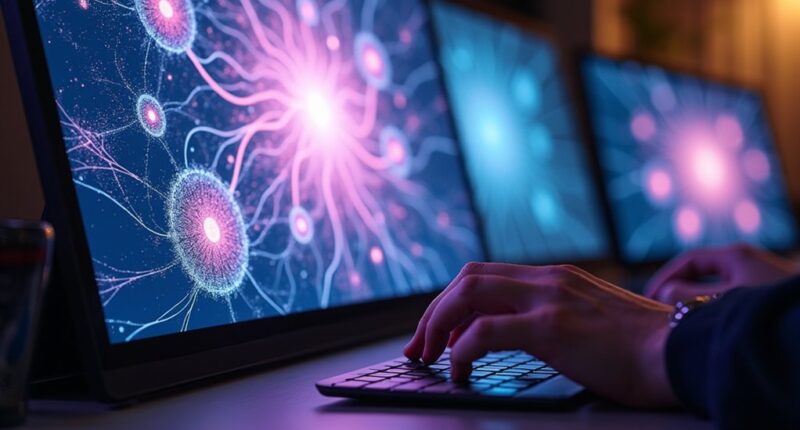Visual AI uncovers the patterns behind your aesthetic instincts by analyzing visual data with advanced recognition systems. It identifies common features like textures, shapes, and colors that appeal to you, helping to explain why certain designs or images resonate. Through techniques like style transfer and image enhancement, AI reveals the subtle elements influencing your preferences. Keep exploring to discover how these innovations deepen our understanding of what makes visuals truly appealing.
Key Takeaways
- Visual AI uses pattern recognition to identify features like textures, edges, and shapes that influence aesthetic preferences.
- Convolutional Neural Networks analyze visual data to categorize images based on aesthetic qualities and similarities.
- Style transfer models reveal emotional and cultural cues by applying stylistic features from one image to another.
- AI-driven enhancement techniques improve visual qualities, aligning images more closely with human aesthetic standards.
- Emerging tools like DALL-E and Midjourney explore underlying patterns by transforming prompts into visual compositions.

Understanding why we find certain images beautiful has long puzzled artists and scientists alike. Recent advances in visual AI have started to reveal the underlying patterns that shape our aesthetic preferences. Pattern recognition systems, which integrate computer vision technologies, are at the forefront of this effort. These systems analyze visual data to uncover common features and structures that appeal to our senses. By measuring similarities between pattern samples, they categorize and classify images based on their aesthetic qualities. Convolutional Neural Networks (CNNs), for instance, are trained on datasets like MNIST to model how patterns relate to visual appeal. These models excel at detecting localized features such as textures, edges, and shapes, which are pivotal in understanding what makes an image attractive. Using techniques like histogram equalization and gamma correction, these systems enhance the visual qualities of images, making the patterns more perceptible and aligning them with our aesthetic principles. Experiments show that such AI-powered systems achieve high satisfaction scores—around 76% of users feel strongly about their outputs—outperforming traditional methods that score between 85 and 92, indicating a significant leap in aligning machine-generated designs with human preferences.
AI uncovers visual patterns that resonate with our aesthetics, achieving high satisfaction and advancing machine understanding of beauty.
Moreover, AI style transfer techniques deepen our understanding of aesthetic elements by applying the stylistic features of one image onto another. These methods, primarily CNN-based or Transformer-based, mimic artistic styles and reveal emotional, cultural, and semantic cues embedded in artworks. Comparing outputs from different models helps identify key stylistic components, offering insights into how certain visual elements evoke feelings or cultural associations. While current style transfer methods have made remarkable progress, they still fall short of capturing every nuance of human artistry, highlighting the complexity of aesthetic perception. Recent research demonstrates that AI models increasingly incorporate both local and global features, which enhances their ability to interpret and transfer complex stylistic patterns. Additionally, the integration of natural materials within design can elevate the visual appeal of spaces, emphasizing the connection between aesthetics and authenticity.
AI-driven graphic design and colorization further illustrate how pattern recognition influences aesthetics. Models generate scalable vector graphics and automatically recolor images, enhancing visual appeal through sophisticated neural networks like GANs and transformers. These models grasp contextual details and semantic content, enabling more realistic and aesthetically pleasing color choices. By integrating semantic understanding, AI can create images that resonate more deeply with viewers’ aesthetic sensibilities.
Finally, tools like DALL-E and Midjourney are transforming art creation by turning prompts into visual compositions. They challenge traditional notions of art and push the boundaries of visual culture, yet also raise questions about preserving digital artifacts and understanding ephemeral aesthetic experiences. As neural network architectures evolve—combining localized feature detection with global relationship modeling—they bring us closer to decoding the patterns behind our aesthetic instincts. Ultimately, AI helps us see the hidden structures that make images beautiful, offering a new lens through which to understand our deep-seated visual preferences.
Frequently Asked Questions
Can Visual AI Predict Individual Aesthetic Preferences?
Yes, visual AI can predict your individual aesthetic preferences. It analyzes low-level features like color and texture, along with high-level elements such as composition and meaning, to understand what appeals to you. By learning from your past choices, AI models can recommend art or designs tailored to your taste. They automatically extract relevant features, making predictions more accurate and personalized, helping you discover new art that resonates with you.
How Does Visual AI Adapt to Cultural Differences in Beauty Standards?
Have you ever wondered if AI can truly understand your culture’s unique beauty standards? It can, by incorporating diverse, regionally representative data and cultural context into its models. You need to guarantee AI recognizes different aesthetic preferences and avoids one-size-fits-all solutions. By doing so, it adapts to cultural nuances, promotes inclusivity, and respects personal identity, making beauty assessments more authentic and meaningful across varied societies.
What Are the Ethical Implications of Using AI to Analyze Aesthetics?
When you use AI to analyze aesthetics, you need to take into account ethical concerns like bias, privacy, and fairness. AI can perpetuate stereotypes, exclude diverse perspectives, and reinforce harmful beauty standards, impacting mental health and societal values. You should ensure datasets are inclusive, maintain transparency about how data is used, and prioritize user consent. Balancing innovation with ethical responsibility helps prevent reinforcing inequalities and respects individual dignity.
Can Visual AI Be Used to Create New Art Styles?
Think of AI as a digital alchemist, transforming raw data into shimmering new art styles. It can indeed create fresh aesthetics by blending traditional techniques with futuristic visions, remixing cultural motifs, and inventing hybrid genres impossible for humans alone. You can harness this power through algorithms like GANs and DeepDream, pushing creative boundaries and shaping unique visual worlds that inspire and challenge our understanding of art’s future.
How Accurate Are AI Predictions Compared to Human Judgment?
AI predictions are moderately accurate but generally fall short of human judgment. You’re likely to find AI detects and classifies content with about 53-60% accuracy, while humans perform slightly better, especially in recognizing human-made art and texts. However, both AI and humans often struggle with precise distinctions, especially in complex or ambiguous cases. Your ability to discern AI from human content varies based on content type and context, but overall, AI still lags behind human intuition.
Conclusion
As you explore these patterns, it’s like revealing a hidden symphony within your mind, where every note and rhythm shapes your taste. Visual AI acts as a guiding compass, illuminating the secrets behind your aesthetic instincts. You’re not just observing; you’re dancing with the subconscious melodies that define your preferences. In this dance of pixels and perceptions, your sense of beauty finds its rhythm, revealing the intricate tapestry woven by your subconscious and technology alike.









